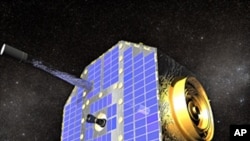Scientists working on NASA's Interstellar Boundary Explorer, or IBEX, satellite have unveiled a new map of the heliosphere. That's the region at the edge of the solar system, where the charged particles from our Sun meet interstellar space. The latest findings add a new layer of mystery to an already puzzling phenomenon.
When IBEX was launched two years ago, scientists expected its map of the heliosphere to show a relatively smooth region more than 15 billion kilometers from Earth.
The first map delivered by IBEX last year showed a dense structure that looks like a ribbon cutting across the sky, with an especially intense "hot spot" in the middle of it. That was puzzling enough.
Now, IBEX principal investigator David McComas of the Texas-based Southwest Research Institute says the latest map shows significant changes in the ribbon in virtually the blink of an astronomical eye.
"Today, we've announced that we observed that this ribbon actually varies on incredibly short time scales, six months," he told reporters in a telephone news conference.
"We didn't understand where the ribbon came from in the first place; it was completely unlike any of the predictions that had come before it. It's even more confounding now, to know that this structure can change on such very short time scales."
McComas explained that the changes over only six months are especially baffling because the two major influences on the heliosphere - the Sun and space - vary at much longer intervals.
"Once we saw a structure, we didn't think we'd see variations on such short time scales in the structure. The time scales for the internal forces for the heliosphere is the solar cycle, 11 years, and for outside [interstellar space], it's tens of thousands of years."
Another IBEX scientist, Nathan Schwadron of the University of New Hampshire, said in the briefing that one reason to try to understand what's going on is that the heliosphere, which in a sense is the outer boundary of the solar system, helps shield us from hazardous interstellar radiation.
"It turns out that these boundaries are actually protective. They protect us from the fairly high energy and dangerous radiation called galactic cosmic rays that pervades the galaxy," Schwadron said.
Understanding changes in that protective boundary could be particularly important in the future, as space flights take humans on long-distance voyages around the solar system.
Scientists Surprised by Rapid Changes in Space Structure
- By Art Chimes





